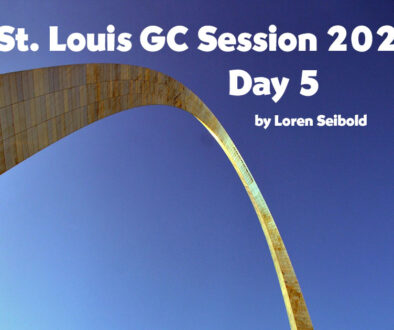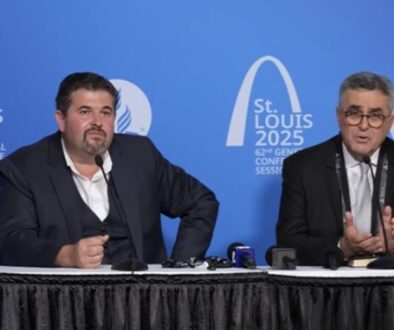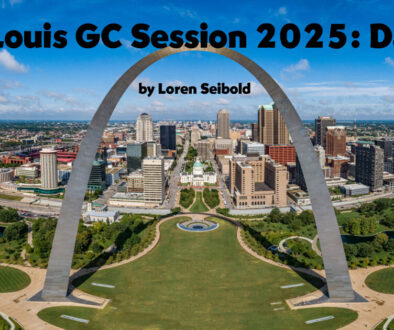The Words of Mary Magdalene
by Desmond Hartwell Murray | 31 March 2024 |
She was there. She stayed there. At the most important tomb in Christianity. The men left. But this was deeply personal for Mary Magdalene, so she stayed. From crucifixion, to burial, to resurrection. She stayed. She ought to be called the patron saint of loyalty. She is a woman touched by God’s love. Even now, Easter 2024, we can feel the depth of blues stirring in her words: “They have taken away my Lord, and I do not know where they have laid Him.” Her words, relatable and poignant, are affecting even now after thousands of years. These words are from one experiencing double loss and grief for a loved one – the loss through death, and loss from removal of their remains. Perhaps, there is also a desecration layered upon a death, a disgrace compounding sorrow.
Here in this singular sentence, her only known recorded words, Mary gives irrefutable evidence that to her, Jesus was not an abstraction, He was not a virtual online “friend,” or some distant spiritual leader. For Mary Magdalene, Jesus was “my Lord.” She was there with Jesus, in geography and history, up close and personal, as we may say. He was not just the Lord, the Savior, the Redeemer; He was hers. She never wrote a book or gave extensive eyewitness accounts about her lived experiences with Jesus, but these few recorded words of Mary Magdalene speak volumes. Her words are a succinct abstract, a distillation as it were, of her life and times with Jesus.
Indeed, Mary Magdalene was a fulfillment and living testament to Job 19: 25-27. For in her flesh, she saw God with her own eyes; she was first witness and responder to a risen Redeemer. She traveled with Jesus supporting His ministry; she saw Him walk on flourishing hillsides and dusty streets; she knew His facial expressions; she heard Him speak life into the lame, the sick, and the dead. She knew the tone of His voice, His inflections, the pitch and sounding of His words. His voice and words were still ringing in her ears and in her spirit as she sat in His empty evacuated tomb. With her own eyes she saw Him heal others; she saw His miracles;, indeed, she herself was healed miraculously by Him. As she sat there, these scenes were constantly replaying like a riveting documentary in her mind. She felt at ease and enriched in His presence; He made her feel beautiful and worthy, “like a natural woman.” For He looked upon her as He does with all humanity, beyond our frailties, and sees our beauty, the image of God. He discerned infinite possibilities within her and awakened Mary’s eternal gratitude.
So, she stayed at His tomb, never wanting to let Him go, and millennia later we hear and feel the deep worry dripping from her words, “They have taken away my Lord, and I do not know where they have laid Him.” She had a habit of staying with Jesus, dead or alive. Amidst the weeping olive trees of Gethsemane, in public view of irreverent Roman soldiers at Calvary, in the ebb and flow of Christ ministry, Mary Magdalene stayed; she was there. Many Christians today refer to her as “apostle to the apostles.” It is therefore unsurprising that she lingered on at His empty tomb. As recorded in John 20, she spoke these words to some of the disciples and to two angels. And unbeknownst to her, at first, she was ironically inquiring of the risen Savior Himself regarding the whereabouts of her beloved Jesus! Today, as it has been throughout Christian history, many too have felt the presence and power of Jesus in their lives, many have experienced His grace and mercy. We have stayed with Him morning, noon, and night, day unto day, throughout our lives, and like Mary are filled with inexpressible gratitude. And, we feel her angst and anguish, and query organized religion: Have you taken away our Lord? And where have you laid Him?
For it seems that throughout the annals of Christianity there have been instances and periods in which some have sought to take away our Lord. They have laid, fossilized, misappropriated, and masked the body and spirit of our living Lord in parochial doctrines and policies, in church buildings and rituals, and in custom and culture. In so doing, many misplace the living Savior! They do so by acts of and excuses for the dehumanization and enslavement of others. They corrupt the living body of Christ by self-righteous pretentiousness, patriarchy, and misogyny.
In their delusions of supremacy over others, they have, for all practical purposes, taken away our Lord and tied Him to misguided politics, privilege, and earthly power. Their religion and faith are exclusionary and supremist, a stunning departure from our John 3:16 Savior – “For God so loved the world.” A God who loves not a part but the whole wide world. They misassign retribution as righteousness. They reflexively discount and devalue the prayers of others, thinking and acting as if God only hears and honors their own. Their track record also includes defiling our Lord’s creation, our environment, in the pursuit of greedy ambitions.
So, we hear these lamentations of the loyal echoed in the lamentations of Mary of Magdalene: “They have taken away my Lord, and I do not know where they have laid Him.” But, after Mary’s gloomy lamentation comes her joyful realization, the Good News of Easter, that Jesus is alive. She was the first to see Him alive, the first to tell the story of her risen Redeemer; she was the first Evangelist, the pioneering Missionary. Try as they may, intentionally or unconsciously, Jesus was not taken away by human hands and institutions. Like the coming of Spring, which cannot be tied up, held down, or taken away by Winter, so too our risen Savior is irrepressible to the grip and darkness of death and grave. “Oh death, where is thy sting?”
The earth cannot contain Him; the heavens will not restrain Him. Rather, as for a buried seed, earth conspires to protect, nurture, and sustain Him for imminent uprising. Jesus is abundantly alive and arisen in the hearts and minds and souls of the thankful. He inhabits and energizes, comforts and strengthens the fellowship of the grateful. He is alive and knocking on doors and hearts as sunlight and rain prod the buried seed to life above ground. As the blossoms, and leaves, and flowers, and fragrances, and seeds of Spring are already present, inchoate in the protective tree buds of Winter, so too He has been present and alive within us. He has been loving us all, the world, as only God can, in good times and bad, in our brokenness and in our blessings, in our troubles and our triumphs, in our risings and in our retirings. He is our Hallelujah chorus, our song of Moses and the Lamb.
They can’t take Him away from us, they can’t tie Him up, or lay Him down. Not ever. He is everywhere. Free. Emancipated. Resurrected. Alive in you and me. The earth is His temple, as are you. The earth is full of His glory, as are you. The earth is full of His love, so are you. We live under the eternal gaze and amazing grace of God. Even in the darkness, in our wretchedness, even beside our grave in the valley of the shadow of death, He abides with us. He is bigger than doctrine and policy, church building and ecclesiastical ritual, custom and culture. He is bigger than our petty politics, privilege, and earthly power. He is larger than life. Mary Magdalene knew it; her words will forever bear witness.
Search for Him and you will find Him. He is already there. Patiently beckoning you to the infinite possibilities of your life. Behold, He is alive.
 Desmond Hartwell Murray is associate professor of chemistry at Andrews University, Berrien Springs, Michigan.
Desmond Hartwell Murray is associate professor of chemistry at Andrews University, Berrien Springs, Michigan.




